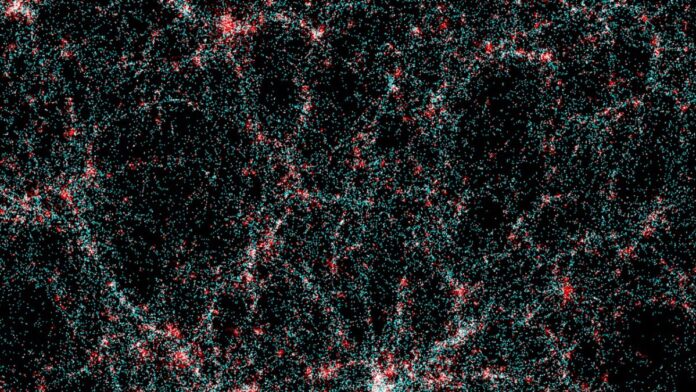Scientists think that only about 5% of the stuff that makes up the universe is known to us.
Yes, you are reading that right. Cosmological models show that invisible energy and matter must make up a combined 95% of the universe for it to work according to existing theories.
The invisible part of the universe consists of two components, dark energy and dark matter. The latter is somewhat less mysterious and scientists are fairly certain of its existence: The rules of gravity simply wouldn’t work without it. Galaxies as we see them wouldn’t have been able to assemble to their current sizes in the time they’ve had since the Big Bang if visible matter was all there was. In fact, many galaxies wouldn’t even hold together as they do, if the gravity of visible matter was the only force pulling them together.
Europe’s new space telescope Euclid will attempt to map this invisible stuff, but what if its findings don’t fit expectations? A lot is at stake, including Einstein’s famed and widely accepted theory of general relativity.
Related: How will Europe’s Euclid space telescope see into the dark universe?
The first observations indicating that dark matter must be prevalent in the universe to prevent things from flying apart were made in the 1930s. Since then, astronomers have found that this invisible dark matter must make up at least 85% of all matter in the universe. Scientists have been trying for decades to detect this invisible matter, which, they think, must consist of some sort of particles, maybe akin to the inert neutrinos that barely interact with the visible world.
The situation with dark energy is, however, more complicated. The discovery of this elusive force dates back to 1998 when astronomers found that the expansion of the universe is accelerating. The expansion itself was initially driven by the energy from the Big Bang, but since the Big Bang happened so long ago (13.8 billion years ago, to be exact), this expansion should be slowing down.
To make up for this conundrum, theorists postulated that some mysterious force, dark energy, must exist that acts against gravity and drives matter apart. Cosmological models show that dark energy accounts for 68% of all energy in the cosmos, according to NASA. But astronomers admit that the evidence for its existence is a bit vague.
“[The acceleration of the expansion] of the universe doesn’t make sense when you think that there’s just gravity there,” Isobel Hook, a professor of astrophysics at Lancaster University in the U.K. and a Euclid scientist, told Space.com. “It shouldn’t be slowing down. So the fact that we observe it getting faster means that there must be something else. And we just call that thing dark energy because we don’t really know at all what it is.”
Hook was a member of the team that made that 1998 discovery and since then has been wondering, just like many other scientists, what this dark energy actually might be.
“We really don’t know,” she said. “The best theory is that it’s probably some kind of property of space itself, like a kind of energy that’s everywhere, at all times, but there’s no explanation for what that should be.”
Models show that this energy must be distributed evenly across the universe and that it has always had the same strength. In the universe’s early days, the effects of dark energy were not as visible, because the original ‘kick’ from the Big Bang was driving most of the universe’s expansion. Some 5 to 6 billion years ago, however, dark energy became “a predominant force, acting against the gravity of both, the normal and dark matter,” Giuseppe Racca, Euclid project manager at the European Space Agency (ESA), told Space.com
“It’s a little bit unsettling, that this energy appears to have a constant density as the universe expands,” Racca said. “It means that [additional] energy is created because the density is constant. It is not diluted by the universe becoming bigger. So it means that there is additional energy.”
There is, however, also the possibility that there is no such thing as dark energy after all, and that the cosmological models that require its existence are wrong. These models are based on Albert Einstein‘s theory of general relativity that describes the physical ‘rules’ of the universe in a series of equations. If future observations by the Euclid telescope (and other upcoming telescopes designed to study dark energy) suggest that dark energy is not such a constant, omnipresent force, that would mean that this famed theory is not entirely correct.
“We know that general relativity works very well at the level of a system,” said Racca. “But there is a possibility that it doesn’t work all that well at cosmic scales and therefore dark energy is not needed.”
Euclid will look for the evidence of dark energy by mapping the distribution of galaxies 10 billion years back in time and comparing how this distribution has changed throughout the evolution of the universe. The observations will reveal whether there really appears to be a constant omnipresent force in action or whether perhaps something else is going on.
“We might find that we don’t see [the effects of] this energy constant everywhere, but we see some differences somewhere or in time,” said Hook. “Then things will get really interesting and it really would be revolutionary, because we’d have to completely change our theories.”
And that would likely mean Nobel Prizes for the discoverers. The Euclid telescope, launched on July 1 by a SpaceX Falcon 9 rocket, will take six years to map one third of the sky outside our galaxy, the Milky Way. Only then will astronomers have enough data to know for sure.

